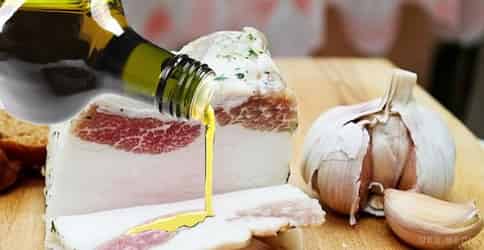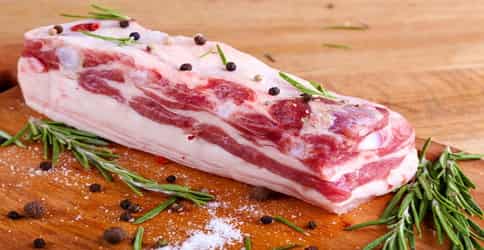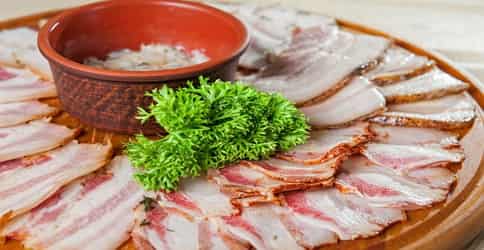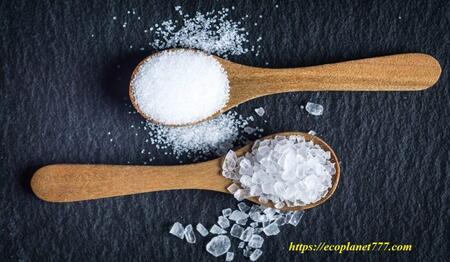
So before you follow the stable trend of no/low fat any longer, hear these few interesting facts about lard and why it could be a great substance to add to your diet.
This rendered pig blubber is not a typical saturated animal fat. With an unusual chemical composition, pure lard contains no trans fats.
And in terms of its fatty acids, it’s better than butter: Lard is 60 per cent monounsaturated fat, which is associated with a decreased risk of heart disease. Butter is 45 per cent monounsaturated fat.
1. It’s as HEALTHY as OLIVE OIL!
Rendering lard, boiling it to a liquid from a hunk of pink fat supplied by the butcher, takes time and effort. If you’re a big foodie, it might be worth the work.
For everyone else, choose liquid oil high in monounsaturated fats, such as olive oil or organic, non-GMO canola oil, which are trendy now and healthy, says Lindzon, even for baking your next birthday cake. “The bottom line is change your grandmother’s recipes that call for butter and lard,” she says.

Lard is an extremely versatile fat: It doesn’t smoke at high temperatures, so it’s perfect for high heat cooking or frying. This also means it doesn’t break down and oxidize, creating harmful free radicals (the reason you don’t cook extra virgin olive oil at high temperatures).
It has less saturated fat than butter. Yes, that’s right lard has 20 percent less saturated fat than butter; it’s also higher in monounsaturated fats, which are good for cardiovascular health. Lard is also rich in oleic acid, the same fatty acid that is in olive oil and praised for its health benefits. In addition, it has no trans fats like its synthetic counterpart, shortening.
Choose lard from pasture-raised pigs. The fat composition of lard rendered from pigs on pasture is better for you than lard from pigs raised in industrial confinement. And if you can, render the lard at home – as commercial lard is bleached and deodorized – and sometimes has actually been hydrogenated to make it last longer (aka trans fats are added!).
In society’s move toward all natural, organic foods, lard certainly has a place on our plates, says Bellissimo, if eaten in moderation, as part of a balanced diet and not every day. “It tastes great, it works well, it’s a very user friendly fat,” he says. “Small amounts of pork fat are functional.”

Those same monounsaturated fats, are responsible for lowering LDL levels while leaving HDL (“good”) cholesterol levels alone. Shocking, right?
Lard also contains high amounts of Vitamin D, a necessary fat-soluble vitamin. It is estimated that 1 tablespoon of lard contains 1000 IU of Vitamin D! As a society, we are extremely deficient in Vitamin D. As a powerful immunity booster, the intake of Vitamin D can prevent those frequent colds and flus in your home each year. Our family caught a cold ONE time this year. ONCE.
2. Lard Is A Fat You Can Count On
What I’m trying to say here is that lard is a stable fat.
It isn’t one of those fats that get broken down super easy.
They call those fats—fats that break down really quickly in an unhealthy form—oxidized fats. When you have oxidized fats they cause free radicals. Free radicals then turn into cell damage.
Lard breaks down properly because it’s more stable. This gives our bodies what they need instead of the junk that causes inflammation, which in turn means you actually have a healthier body.

3. Lard is neutral flavored
Like me, many of you choose to cook with coconut oil because it is a heat-stable cooking fat. Coconut oil does impart a mild-to-moderate coconut flavor to dishes, however. And while I enjoy the flavor, sometimes I want a neutral-flavored option. That’s when I choose lard.
For sautéing and deep-frying, nothing beats the cooking properties of lard. It creates a divinely brown crust to vegetables and meats without a distinct flavor. Due to the neutral flavor, it also works exceptionally well in baked goods
4. Lard is great for baking
You may not think that lard pairs well with sweet foods, but traditionally lard was used for deep frying donuts and making flaky pie crusts. If you haven’t made a pie crust with lard, you are in for a beautiful surprise! In baked goods, lard lends tenderness and moisture without a discernible flavor.
Lard has about half as much saturated fat as butter, but about double the saturated fat found in olive oil.
Saturated fat raises LDLs, the bad cholesterol, and lowers HDLs, the good cholesterol. It’s associated with heart disease, hypertension, diabetes and obesity, but it is also vital to metabolism and cell function.
Lard is a source of linoleic acid, an omega 6 fatty acid most North American diets get too much of, but also associated with our body’s normal inflammatory response.
- Magnetic storms: the sun is testing the planet🌪️ - 13.06.2024
- Why You Should Drink Chicory: Benefits and Harms 🌿 - 09.06.2024
- Innovative Choice: Sproud Milk – Your Ideal Plant-Based Drink 🌱 - 03.06.2024


